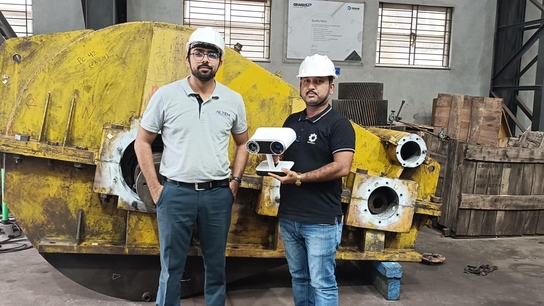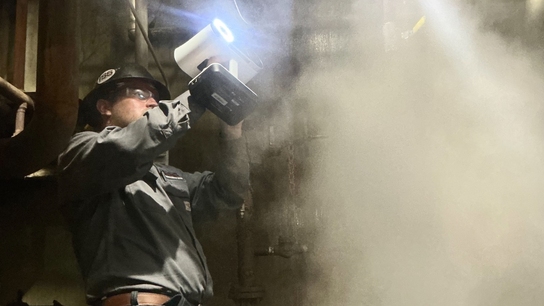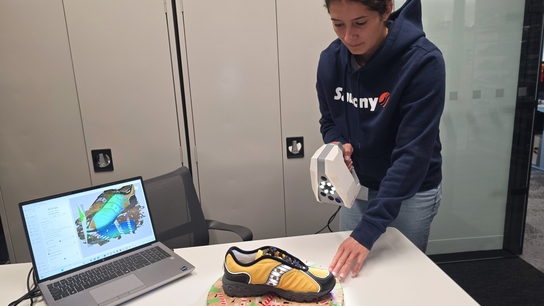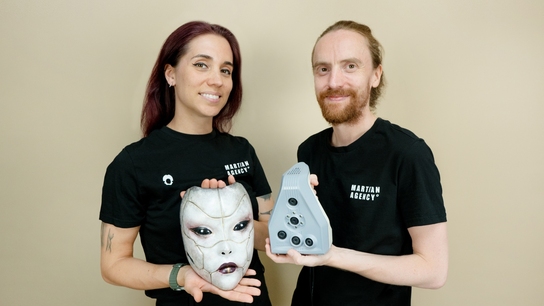Supporting the livelihoods of Armenian war victims with Artec Eva and customized prosthetics
Challenge: The conflict between Armenia and Azerbaijan dates back decades, and continues till today. Many citizens – specifically men as young as 18 – have sustained injuries with a high incidence of lost limbs and injuries to the hands and legs. With a poorly developed infrastructure and difficulty accessing quality healthcare, many have poorly fitted prosthetics and subpar solutions.
Solution: Artec Eva, Artec Studio, Artec Cloud, 3D printing
Outcome: War victims and patients are scanned using Artec Eva, with the data captured used for creating customized prosthetic shields. For those in inaccessible areas, the data is easily uploaded onto Artec Cloud, allowing collaboration.
Why Artec: Easy-to-use and incredibly portable, Artec Eva allows the quick and easy capture of data, while Artec Cloud negates troublesome data transfers and allows the team to operate remotely.

Capturing 3D data from patients to create customized prosthetic shields.
New technology for sustainable solutions
Artyom folds his hands in front of him as he speaks – the gesture comes naturally, as it would anyone. The way we move our hands is, for most, an essential part of non-verbal communication. For Artyom, a young man who lost both his hands in an accident, it is no different.
“Before an accident in 2003, I was a football player,” said Artyom. “I was a goalkeeper. But after that, obviously, if you don’t have upper limbs you can’t be a goalkeeper anymore. But my love for the sport did not go away – I still love it, watch it, play it. So I thought maybe I could be a coach.”
Artyom, who now coaches two women’s teams, now has a dream – to have good arm prosthetics that fit, are comfortable, and are functional. And he isn’t alone in this struggle. Because of a higher than average number of amputees in Armenia, along with limited access to quality healthcare and many living in poor conditions, there are many who live with suboptimal solutions for prosthetics.

Artyom (right) is shown a prototype of a new prosthetic.
“The situation in Armenia was such that no one cared very much about upper limb prosthesis,” said Hajk Bagradjans, co-founder and CEO of oqni, an Armenian-based NGO. “And while there are some companies that import prostheses from overseas with support from the Ministry of Social Affairs, the process is very bureaucratic. Even if you get the prosthesis, after two to three weeks it is broken – you see the skin.”
It is this challenge that inspired the forming of oqni, an organization made up of members of the Armenian diaspora, all of whom have come together to create improvements and develop long-term solutions for the community.
“Due to military escalations, an earthquake in 1989, a high rate of road accidents, and diabetes, there is a disproportionately high number of amputees in Armenia.”
“Oqni was formed as a result of the war in Armenia in 2020,” explains Bagradjans. “Because of the war, there were a lot of young people who, especially in rural areas, faced the dilemma of having no access to prosthetics, and not having prosthetics customized to them – something that they could feel comfortable and confident in.”

Artec Eva being used to capture data of patients for building customized prosthetic shields.
But in Armenia, the problem goes beyond war victims – oqni says that throughout the country, there is a disproportionately high number of amputees. Many of these are due to other military escalations over the years, due to an earthquake that hit in 1989, a high rate of road accidents, as well as diabetes.
“After the earthquake, a lot of foreign companies and aid workers came and trained people on how to do prosthetics. But over the last 30 years, it hasn’t changed much,” said Bagradjans. “So, they’re still using the old ways, but they have a very strong interest in being exposed to new technologies.”
Find a solution
The story of how new technologies came into play goes further back than this. In 2020, as the Covid-19 pandemic raged on in especially high numbers in Paris, French surgeon Dr. Roman Khonsari put his Artec scanner to use: for quality control of 3D-printed emergency medical supplies that were in high demand and rapidly becoming unavailable.
A member of the Armenian diaspora himself, Dr. Khonsari then recommended Artec technology to his colleagues as they formed the idea of starting an NGO.
“Dr. Khonsari and I are currently working on a humanitarian project to bring 3D technology to Armenia in order to build prosthetic equipment there,” an email from oqni member Sassoun Kelechian to Artec 3D read. “We’d like to discuss using Artec 3D scanners for this.”
And as the plan for incorporating 3D technology developed, so did the team.
“In our growing team, we have everything from psychologists to engineers to physiotherapists to business people,” said Bagradjans. “So we now have a huge selection of people and from Germany, France, the US, Armenia – we have people from across the world. And I think this is something that really adds to our DNA and really allows us to become better at what we do.”

The Artec and oqni team on a visit to the Ortez orthotic and prosthetic center.
In the case of scanning body parts with a focus on accuracy, and ease of use, Artec Eva was the ideal option. The flagship scanner of Artec 3D, Artec Eva is excellent for scanning medium-sized objects. Light and easy to maneuver, the structured-light 3D scanner guarantees making quick, textured, and accurate 3D models. Eva scans quickly, too, an important consideration when working with objects or surfaces that might move – such as people – and gives you precise measurements in high resolution.
The customized item in this case: Prosthetic covers.
“These are essentially an aesthetic and protective covering of your prosthetic,” Bagradjans explained. “So instead of walking around with a tube with just a metal bar hanging out, or having a foam solution – that is usually very uncomfortable and not very hygienic, and not at all designed according to the size of your other leg – our solutions are prosthetic covers that, when combined with 3D scanning technology, offer a very customized solution that not only corresponds to the size and dimensions of your healthy leg or your body shape, but also (thanks to 3D printing) allows us to accommodate any size, design preferences, or any kind of preferences that you might have.”
Before Eva was added to the workflow, a far more time-consuming process was in place.
“Scanning with Eva allows us to really integrate the whole shape of the healthy leg, and for it to be very symmetrical.”
“The Eva 3D scanner was very much a game changer for us,” Bagradjans said.” Before, we had to do everything manually. When we were creating prosthetic covers, we had to manually take all the measurements, which is fine, but it does not really allow you to be very accurate.”
Following interviews with patients, the oqni team discovered several things: Firstly, that one of the biggest factors in a good prosthetic was that the prosthetic cover should replicate the dimension and shape of the other leg. “For patients, it was very important that when they wear trousers, no one could actually tell what the difference is,” said Bagradjans. Even when wearing shorts, a symmetry between both legs could be maintained.
“Without Eva, we would have had a rather rudimentary way of just manually taking different sizes and then trying to accommodate that,” he explained. “But the 3D scanning solution really allows us to have a much higher accuracy – it allows us to really integrate the whole shape of the healthy leg, and for it to be very symmetrical.”
How it works: a patient is first invited to meet with the oqni team, in their home, in the office, or wherever is most suitable for them – something made possible thanks to the mobility of the scanner. Then, the team gets to know the patient a little – not only about their amputation, but about what colors they like, or what designs they prefer.
“For example, we had one patient who was really into Gothic culture, and we said ok, we’re probably going to put a skull on this cover – so it is really about understanding who the patient is,” shared Bagradjans.
The scanning then begins. The patient stands in the middle of the room, and in one scan, both the healthy leg and the amputated leg are captured. In the case of a double amputee, both amputated legs are scanned.

Both the prosthetic leg and the original leg are scanned for full data capture.
The average scan doesn’t take more than a minute, but in some cases, such as when a patient is unaccustomed to standing or holding themselves still, it can take up to five minutes.
Next, the scan data is processed. Here, in Artec Studio, the Mirror feature is used, mirroring the healthy leg onto the prosthetic leg. “This is so that we get the most accurate dimensions, and can better understand how to create a prosthetic cover, and what the shape of the prosthetic cover should be – the prosthetic cover should have the fittings like fit the cover precisely onto the metal tube – so now we have the dimensions, and we know exactly where the fixing mechanism should be.”
Another game-changer for the team is Artec Cloud. “It’s all about decentralizing prosthetics and access to rehab,” Bagradjans said, “and Artec Cloud is very much part of that DNA.”
Working with Artec Cloud allows team members or partners in further away regions to scan a patient and receive instant feedback. “So, for example, someone who has just recently learned how to scan or is not very familiar with the technology – it is now possible for them to scan and share it on Cloud, and for us to be able to give feedback straight away.”
Once data capture is complete, 3D modeling of the cover begins. “And here we incorporate the feedback of the first stage: where we just got to know the patient, about the colors, what the design should be, about how many holes they should have [to fit the prosthetic].”
And then it’s on to the final stage: print it, and fit it to the patient.
Carry yourself with confidence
While the team is hard at work on creating customized prosthetic shields for their patients, there’s another factor that is not to be overlooked: mental health.
Clinical psychologist and oqni’s Chief Operations Officer Haikouhi Oroudjian came on board to help her country the way she was trained to.
“Just because your body has changed, it doesn’t mean your life is worse; it’s just different. And there are ways to make it better.”
“When I met Hajk, we started talking about how solutions regarding mental health could help the community because there’s a huge stigma around mental health in Armenia and in the Caucasus,” she explained. “Specifically, post-war trauma.”
While creating prosthetic covers is essential to what oqni does, incorporating human sciences, mental health, and the patient’s well-being into the equation is just as crucial. “Otherwise, there really is no point,” said Oroudjian, whose grandmother was herself an amputee. “You could give someone a prosthetic that’s made of gold, and give them every single helpful tool in order to help their prosthetic physically work – but if there’s an emotional rejection of that new aspect of their body, then it’s not going to matter.”

It’s not only the physical aspect that’s important as a solution; psychology plays a huge part, too.
Given the nature of oqni’s patients, change is inevitable. “When your body changes, especially when you’re a young, 18-year-old boy, or if you have diabetes, something that is solely yours – your body – changes. There’s a shift in your brain that you really need to address to help you feel okay to wake up every morning,” Oroudjian said. “And to understand that just because your body has changed, it doesn’t mean your life is worse; it’s just different. And there are ways to make it better.”
Working with other organizations
Beyond the creation of prosthetic shields, oqni has strong ties with local and international organizations, too. For example, Ortez Orthotics Centre, which works with a variety of patients who have mobility issues.
“Amputees in Armenia are mainly financially disabled,” the director of Ortez, Araig Tekyozyan, said. “It is harder for an amputee to get a job, and receive a good pay. There are professional difficulties because amputees cannot have professions related to physical labor anymore.”
On top of that, many do not have sufficient knowledge or skills in IT or programming – industries that require less physical labor and would otherwise be more accessible to them.
“We saw this opportunity to improve amputees’ physical conditions in the overall system and help them live with full lives,” he added.

The director of Ortez is a strong advocate for the use of high technology when working with patients.
“Despite being a small country, we have high-quality prosthetics and prosthetics installation,” Tekyozyan said. “3D scanning and CAD/CAM opportunities are also very important for working with non-mobile patients.”
With Eva, just one professional needs to visit a patient. “With a single small portable device, you can take measurements without making the patient feel any discomfort,” he said. “Along with being modern, this technology is really comfortable – I think that this technology is highly needed.”
Moving boldly into the future, oqni has also teamed up with Armbionics, who operate from the same space, Yerevan’s Engineering City, as them. This Armenian initiative specializes in biosignal-based electrical hands, where myoelectric signals allow the moment of the prosthetic hand. Patients can then control the electrical hand more intuitively through electrical signals that are received from muscles by using surface EMG Sensors, allowing one, two, or five-finger grips.
On top of that, oqni trains students, veterans, entrepreneurs, and more at universities and at the local TUMO Labs, where they run education-based programs.

The oqni team works with students and 3D enthusiasts in Yerevan’s TUMO Lab.
Where we are, where we’re going
Since their inception over a year ago, oqni has helped over 120 amputees in Armenia with 3D-printed prosthetic covers. They have also worked to create a physiotherapy and mental health booklet and app, and are developing scientific and educational initiatives.
“We are advocating, we put a lot of resources into educating the next generation of bionic engineers of hardware engineers, of software engineers, designers, who all come together here,” said Bagradjans, referring to those who attend training sessions in TUMO Lab every week.
Rather than limiting their efforts to where it all began, oqni is now preparing for its next steps of making their solutions open-source and freely available for amputees across the world.
“Through a 3D modeling course, war veterans and amputees can learn modern tools and re-enter the workforce.”
And what more social way to help than to pay it forward? The individuals who were once patients are now stepping up to contribute, too – an initiative to upskill amputees, veterans, and those affected by war to become 3D modeling professionals is now underway.
“True to its mission – to empower amputees – oqni believes that if given the right tools and opportunities, anyone can achieve their goals and dreams,” said Oroudjian. “By creating a 3D modeling course, war veterans and amputees can learn modern tools and re-enter the workforce feeling more confident and prepared than before.”
And their learning and opportunity doesn’t stop there, either.
“The best candidates will join the oqni team and help build the solutions for the future.”
Scanners behind the story
Try out the world's leading handheld 3D scanners.





